Willie Skipper
The trickery of the Willie Skipper (a great name for this move) is learning to make a slippery transition by sliding your board on the water like a sled. This is accomplished by breaking the fin out of the water and transferring your weight over the wide scoop of the board where the rails are soft. Along with the Forward Loop, the Willie Skipper is a compulsory maneuver for the accomplished freestylist and an embarrassment when lacking in one's arsenal. This was a very difficult move for me to learn and took me the better part of a year to master; due to the initial similarity to the jump jibe. Which is unfortunate because the feeling is nothing like a Jump-Jibe.
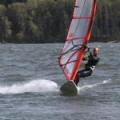
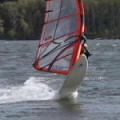

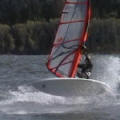
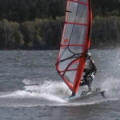
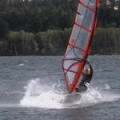
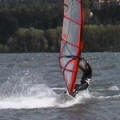
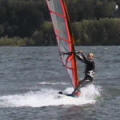
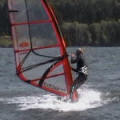
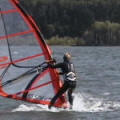
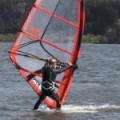
Rider: Royn Bartholdi
Steps
 1)
Unhook, move the back foot behind (or just in front of) the back footstrap. Make sure the front foot is very loose in the front strap. Center your body over the board. Relax and bend your knees but keep your upper torso upright and over the board.
1)
Unhook, move the back foot behind (or just in front of) the back footstrap. Make sure the front foot is very loose in the front strap. Center your body over the board. Relax and bend your knees but keep your upper torso upright and over the board.  2)
Move your back hand on the boom and head into a small piece of chop if possible. Push down with the back foot to jump the board out of the water while keeping your weight centered by hanging down on the boom with your forward arm. Sheet out with the sail so there is no power but keep the mast vertical. Focus on getting up with your body so you are over the board and not leaning back like a jump jibe. The energy is UP.
2)
Move your back hand on the boom and head into a small piece of chop if possible. Push down with the back foot to jump the board out of the water while keeping your weight centered by hanging down on the boom with your forward arm. Sheet out with the sail so there is no power but keep the mast vertical. Focus on getting up with your body so you are over the board and not leaning back like a jump jibe. The energy is UP.  3)
Pull the clew hand up toward the sky. This forces the board underneath you, keeps the mast vertical, and causes a better pivot around the mast. Also, aggressively pull the front foot toward your chest.
3)
Pull the clew hand up toward the sky. This forces the board underneath you, keeps the mast vertical, and causes a better pivot around the mast. Also, aggressively pull the front foot toward your chest.  4)
Guide the board around the mast by using the foot in the front foot strap. The board should rotate around and flat rather than up and over. Keep your body weight forward over the board. Place the back foot on the deck in front of the mast as the board swings around.
4)
Guide the board around the mast by using the foot in the front foot strap. The board should rotate around and flat rather than up and over. Keep your body weight forward over the board. Place the back foot on the deck in front of the mast as the board swings around.  5)
Try to land with the nose hitting the water and the mast vertical. Your front foot will naturally come out of the strap as the tail swings around.
5)
Try to land with the nose hitting the water and the mast vertical. Your front foot will naturally come out of the strap as the tail swings around.  6)
Land the board with your body vertical and over the center of board, solid on both your feet. The board will slide like a winter sled on a snow covered hill in northern Minnesota.
6)
Land the board with your body vertical and over the center of board, solid on both your feet. The board will slide like a winter sled on a snow covered hill in northern Minnesota.  7)
Push the new front foot so it is extended straight and pointing toward the tail of the board. Begin to transfer your weight to the front foot so the board levels out and increases the distance of your slide.
7)
Push the new front foot so it is extended straight and pointing toward the tail of the board. Begin to transfer your weight to the front foot so the board levels out and increases the distance of your slide.  8)
Keep sliding the board by bearing off wind, the longer the better. Maintain your body weight over the mast foot. You can sheet in a tad to keep the board sliding.
8)
Keep sliding the board by bearing off wind, the longer the better. Maintain your body weight over the mast foot. You can sheet in a tad to keep the board sliding.  9)
Now shift your weight more toward the tail of the board so you can complete the directional transition by letting go of the back hand and grabbing the mast below the boom.
9)
Now shift your weight more toward the tail of the board so you can complete the directional transition by letting go of the back hand and grabbing the mast below the boom.  10)
Grab the other side of the boom with the upper hand and open your shoulders to the new board direction.
10)
Grab the other side of the boom with the upper hand and open your shoulders to the new board direction.  11)
Pull the mast to your body, step back on the board, and reposition your hands. You're done and skipper of your boat.
11)
Pull the mast to your body, step back on the board, and reposition your hands. You're done and skipper of your boat. Tips
- When jumping the board you can pull up with the back hand to force a faster board rotation in the air. This is helpful in under powering conditions but sometimes the board gets out of control.
- If you have a tendency to lean back like everyone else then try shifting your hands toward the mast before you jump the board. This may force you more over the board.
- Some people like to put the back foot behind the footstrap when they jump the board. This can be really helpful however your body will be farther back on the tail which is detrimental.
- There is a tendency to head up wind like a jump jibe however good slides happen down wind. Try not to head too much up wind it at all.
- The fear of this move is ubiquitous and rightly so because you can get your front foot caught in the footstrap. Make sure to wiggle your foot loose in the strap.
- Your in more danger of getting hurt when lean back. Because then you will plow into the board on mistakes. When you lean forward and are over the top of the board then usually you flip over the top of the board into the water on a crash.
- Focus on bringing your front knee to the chest and then guiding the foot out and away. The key is to be over the board and guiding the rotation with your front foot, albeit a fast movement.
All Contents Copyright © 2008-2025 Royn Bartholdi. All Rights Reserved